Papal armorial
Papal coats of arms are the personal coat of arms of popes of the Catholic Church. These have been a tradition since the Late Middle Ages, and has displayed his own, initially that of his family, and thus not unique to himself alone, but in some cases composed by him with symbols referring to his past or his aspirations.[1][2][3] This personal coat of arms coexists with that of the Holy See.
Although Boniface VIII (1294-1303), Eugene IV (1431-1447), Adrian VI (1522-1523) and a few others used no crest above their escutcheon, from John XXII (1316-1334) onward the papal tiara began to appear (a custom maintained until Nicholas V)[4] and, from the time of Nicholas V's successor, Callistus III (1455-1458), the tiara combined with the keys of Peter.[1][5]
Even before the early modern period, a man who did not have a family coat of arms would assume one upon becoming a bishop, as men did when knighted[6] or on achieving some other prominence.[7] Some who already had an episcopal coat of arms altered it on being elected to the papal throne.[1] The last pope who was elected without already being a bishop was Gregory XVI in 1831 and the last who was not even a priest when elected was Leo X in 1513.[8]
In the 16th and 17th century, heraldists also made up coats of arms for earlier popes, especially of the 11th and 12th centuries.[9] This became more restrained by the end of the 17th century.[10]
External ornaments

Papal coats of arms are traditionally shown with an image of the papal tiara and the keys of Peter as an external ornament of the escutcheon. The tiara is usually set above the escutcheon, while the keys are in saltire, passing behind it (formerly also en cimier, below the tiara and above the shield). In modern times, the dexter and sinister keys are usually shown in gold (or) and silver (argent), respectively. The first depiction of a tiara, still with a single coronet, in connection with papal arms, is on the tomb of Boniface VIII (d. 1303) in the Archbasilica of Saint John Lateran.[11] Benedict XVI in 2005 deviated from tradition in replacing the tiara with the mitre and pallium (see Coat of arms of Pope Benedict XVI).
The two keys have been given the interpretation of representing the power to bind and to loose on earth (silver) and in heaven (gold), in reference to Matthew 16:18–19:
- "You are Peter, and upon this rock I will build my church, and the gates of hell shall not prevail against it. I will give you the keys of the kingdom of heaven, and whatever you bind on earth shall be bound in heaven, and whatever you loose on earth shall be loosed in heaven."
The gold key signifies that the power reaches to heaven and the silver key that it extends to all the faithful on earth, the interlacing indicating the linking between the two aspects of the power, and the arrangement with the handles of the keys at the base symbolizes that the power is in the hands of the pope.[12]
The oldest known representation of the crossed keys beneath the papal tiara in the Coats of arms of the Holy See dates from the time of Pope Martin V (1417–1431). His successor Pope Eugene IV (1431–1447) included it in the design of a silver coin.[13] Martin V also included the keys in his personal arms (those of the Colonna family); however he did not show them as external ornaments, instead placing them in chief on the shield (this example was followed by Urban V and VIII and Alexander VII; Nicolas V seems to have used just the crossed keys and the tiara in an escutcheon. The placing of the keys above the shield becomes the fashion in the early 16th century, so shown on the tomb of Pius III (d. 1503). Adrian VI (1522/3) placed the keys in saltire behind the shield.[14]
High Middle Ages
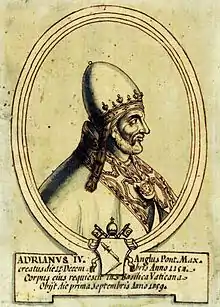
Heraldry developed out of military insignia from the time of the First Crusade.
The first papal coats of arms appeared when heraldry began to be codified in the 12th to 13th centuries. At first, the popes simply used the secular coat of arms of their family. Thus, Innocent IV (1243-1254), who was born Sinibaldo Fieschi, presumably used the Fieschi coat of arms, as did Adrian V (Ottobon de Fieschi), the nephew of Innocent IV. According to Michel Pastoureau, Innocent IV (1243-1254) is likely the first who displayed personal arms, but the first of whom a contemporary coat of arms survives is Boniface VIII (1294-1303).[15]
Modern sources show attributed arms of the popes of the second half of the 12th century; thus, editions of the Annuario Pontificio of the 1960s presented the arms of the popes beginning with Innocent III (1198-1216),[16] and John Woodward gave those of the popes from Lucius II (1144-1145) onward, though he noted that "it seems probably that many of the early popes made little if any use of their family arms".[3] Thus, Innocent III (Lothaire de Segni, 1160–1216) and Gregory IX (Ugolin de Segni, 1145–1241) may have used the coat of arms of the counts of Segni.[17]
The following papal coat of arms should be considered traditional, lacking contemporary attribution. For the popes of noble families, the coats of arms of the family is substituted, and for commoners, the traditional coat of arms as shown in early modern heraldic sources.
| Arms | Description | Pope | Notes |
|---|---|---|---|
| Gules a bear rampant proper.[18] | Lucius II (Gherardo Caccianemici dal Orso, 1144–1145) | ||
| Argent, a crescent azure, in chief a label gules.[18] | Eugene III (Bernardo Pignatelli [da Pisa], 1145–1153) | ||
| Per fess or and bendy or and vair in chief two lions rampant affrontés vert, overall a fess gules. | Anastasius IV (Corrado Demetri della Suburra, 1153–1154) | ||
| (Arms unknown.) | Adrian IV (Nicholas Breakspear, 1154–1159) | ||
| Or. | Alexander III (Roland of Siena, 1159–1181) | Often depicted (as in the Archbasilica of Saint John Lateran) as Or, diapered. | |
| Lozengy azure and argent. | Lucius III (Ubaldo Allucingoli, 1181–1185) | ||
| Quarterly gules and argent, in the centre point a sieve in profile or. | Urban III (Uberto Crivelli, 1185–1187) | ||
| Gules two swords argent in saltire, the hilts in chief or, between four mullets of the last. | Gregory VIII (Alberto di Morra, 1187) | ||
| Chequy argent and gules a chief of the Empire.[18] | Gregory VIII (Paolo Scolari, 1187–1191) | ||
 | Bendy gules and argent on a chief of the second a rose of the first, the chief soutenu by a divise or, thereon an eel naiant azure. | Celestine III (Giacinto Bobone, 1191–1198) | Arms of the Orsini family. |
 | Gules, an eagle chequy sable and or, crowned of the second.[19] | Innocent III (Lotario dei Conti di Segni, 1198–1216) | Arms of the Conti di Segni. The eagle's crown in the Conti arms arose in the 14th century, but is anachronistically also shown in this 13th-century pope's arms. |
 | Bendy gules and or; in chief a rose surmounted by a martlet and supported by two lions respectant gules. | Honorius III (Cencio Savelli, 1216–1227) | Arms of the Savelli family, also used by Honorius IV (Giacomo Savelli, 1285–1287). Woordward blazons the field as per fess argent and or [though this is questionable, given that it violates the tincture rule] rather than bendy gules and or and also includes over all a fess vert on the field and adds in base three bends of the last [gules].[19] |
 | Arms of the Conti di Segni (vide supra, Innocent III)[16]. | Gregory IX (Ugolino dei Conti di Segni, 1227–1241) | |
 | Gules a lion rampant or holding a castle triple-towered or. | Celestine IV (Goffredo Castiglioni, 1241) | |
 | Argent three bends azure (or Bendy argent and azure). | Innocent IV (Sinibaldo Fieschi; 1241-1254) | Also used by his nephew Adrian V (Ottobon de Fieschi, 1276) |
 | Arms of the Conti di Segni (vide supra, Innocent III and Gregory IX)[16] | Alexander IV (Rinaldo dei Conti di Segni, 1254-1261) | |
 | Quarterly 1 and 4 azure a fleur-de-lis or; 2 and 3 argent a rose gules. | Urban IV (Jacques Pantaléon, 1261-1264) | Woodward blazons with different tinctures: 1 and 4 or a fleur-de-lis azure; 2 and 3 azure a rose or.[19] |
 | Or an eagle displayed sable vanquishing a dragon gules. | Clement IV (Gui Foucois, 1265-1268) | His family arms are described by Woodward as Or an eagle displayed sable, on a bordure gules ten bezants (different in the lack of a dragon and the addition instead of a bordure), but the tomb of Clement IV at Viterbo has a shield charged with Or six fleurs-de-lis azure in orle; these do not appear to have been his personal arms and may instead refer to his French origin.[20] |
 | Per fess embattled gules and azure. | Gregory X (Teobaldo Visconti, 1271-1276) | Arms of the House of Visconti. |
 | Azure three pallets or, on each as many fleur-de-lis of the field. | Innocent V (Pierre de Tarentaise, 1276-1276) | |
 | Quarterly, 1 and 4 argent three crescents gules; 2 and 3 sable two pallets or. | John XXI (Pedro Julião, 1276-1277) | |
 | Arms of the Orsini family (vide supra, Celestine III) | Nicholas III (Giovanni Gaetano Orsini, 1277-1280) | |
 | Argent a bend vairy gules and or. | Martin IV (Simon de Brion 1281-1285) | Woodward records Martin IV's arms as Per fess gules and or, in chief a human arm, issuant from the sinister flank proper, vested and manipled ermine.[21] |
 | Arms of the Savelli family (vide supra, Honorius III). | Honorius IV (Giacomo Savelli, 1285-1287) | |
 | Argent a bend between two estoiles azure, on a chief of the last three fleurs-de-lis or. | Nicholas IV (Girolamo Masci, 1288-1292) | Sometimes the arms are emblazoned with three (rather than two) estoiles. |
 | Or a lion rampant azure over all a bend gules. | Celestine V (Pietro Angelerio, 1294-1294) | |
Late Middle Ages and Renaissance
Note that some of the images of the coats of arms shown below anachronistically include the external adornments of the papal tiara and the keys of Peter. These ornaments were not in use before the 1450s.
| Arms | Description | Pope | Notes |
|---|---|---|---|
 | Or two bends wavy azure. | Boniface VIII (Benedetto Gaetani, 1294-1303) | The field is also seen blazoned as argent instead of or.[21] This is an early form of the Gaetani coat of arms, and the first coat of arms documented to have been used by a pope in contemporary sources (Boniface VIII is depicted with his arms by Giotto di Bondone). |
 | Per pale, argent and sable. | Benedict XI (Nicolas Boccasini, 1303-1304) | Woodward blazons Benedict XI's arms as Gules a pale embattled counter-embattled argent, a chief azure, but questions the tincture of the chief.[21] In the Gesta Pontificum Romanorum by Giovanni Palazzo (Venice 1688), the arms blazoned by Woodward are described, and shown with the chief Per pale, sable and argent; only later sources depict the arms (as shown at left) as blazoned entirely as of the chief described by Palazzo. |
 | Barry argent and gules. | Clement V (Raymond Bertrand de Got, 1305-1314) | |
 | Quarterly 1 and 4 or a lion rampant azure, an orle of hurts, 2 and 3 barry gules and argent. | John XXII (1316-1334) | Woodward specifies the main charge as specifically being "between six hurts", rather than (as depicted at left) the hurts being in orle. Beginning with John XXII, popes would occasionally surmount their heraldic shield with the tiara (but they did not yet use the keys of Peter).[22] |
 | Azure an escutcheon argent. | Benedict XII (Jacques Fornier, 1334-1342) | |
 | Argent a bend azure between six roses in orle gules. | Clement VI (Pierre Roger, 1342-1352) | Also used by his nephew, Gregory XI. |
 | Gules a lion rampant or debruised by a bend azure, on a chief of the field, soutenu by a divise of the last, three escallops of the second. | Innocent VI (Étienne Aubert, 1352-1362) | |
 | Gules a chief dancetty or. | Urban V (Guillaume de Grimoard, 1362-1370) | |
 | Arms of the Roger de Beaufort family (vide supra, Clement VI). | Gregory XI (Pierre Roger de Beaufort, 1370-1378) | |
 | Or an eagle displayed azure. | Urban VI (Bartolomeo Prignano, 1378–1389) | |
 Nicholas V (Tommaso Parentucelli; 1447–1455) was the first to use the keys of Peter as heraldic device. He would remain the only pope to choose a coat of arms upon his election (and not use his family arms) until the 18th century (Pope Pius VI). Whether this choice was a demonstration of humility, or due to a lack of a family coat of arms (Parentucelli was the son of a physician) is not known.[22]
Nicholas V (Tommaso Parentucelli; 1447–1455) was the first to use the keys of Peter as heraldic device. He would remain the only pope to choose a coat of arms upon his election (and not use his family arms) until the 18th century (Pope Pius VI). Whether this choice was a demonstration of humility, or due to a lack of a family coat of arms (Parentucelli was the son of a physician) is not known.[22] Coat of arms used by Callixtus III (Alfons de Borja, 1455–1458). Beginning with Callixtus III (successor of Nicholas V who used the keys of Peter as heraldic charges), popes began using the keys of Peter with the tiara placed above them as external ornaments of their coats of arms.[22]
Coat of arms used by Callixtus III (Alfons de Borja, 1455–1458). Beginning with Callixtus III (successor of Nicholas V who used the keys of Peter as heraldic charges), popes began using the keys of Peter with the tiara placed above them as external ornaments of their coats of arms.[22] Coat of arms used by Pius II (Enea Silvio Bartolomeo Piccolomini, 1458–1464) and by Pius III (1503, born Francesco Todeschini Piccolomini). Francesco Todeschini was received as a boy into the household of Aeneas Silvius, who permitted him to assume the name and arms of the Piccolomini family (his brother Antonio being made Duke of Amalfi during the pontificate of Pius II).
Coat of arms used by Pius II (Enea Silvio Bartolomeo Piccolomini, 1458–1464) and by Pius III (1503, born Francesco Todeschini Piccolomini). Francesco Todeschini was received as a boy into the household of Aeneas Silvius, who permitted him to assume the name and arms of the Piccolomini family (his brother Antonio being made Duke of Amalfi during the pontificate of Pius II).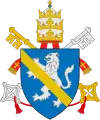 Coat of arms used by Paul II (1464-1471)
Coat of arms used by Paul II (1464-1471)
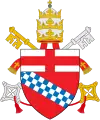 Coat of arms used by Innocent VIII (1484-1492)
Coat of arms used by Innocent VIII (1484-1492)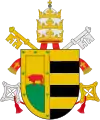 Coat of arms used by Alexander VI (1492-1503), the second Borgia pope, a coat of arms derived from that of the Borgia family with two keys saltire and a tiara.
Coat of arms used by Alexander VI (1492-1503), the second Borgia pope, a coat of arms derived from that of the Borgia family with two keys saltire and a tiara. Coat of arms used by Julius II (1503-1513), the second Della Rovere pope.
Coat of arms used by Julius II (1503-1513), the second Della Rovere pope.
Popes of the Early Modern period
Most popes of the 16th to 18th centuries came from Italian noble families, but there were some exceptions, such as Sixtus V (1585-1590), who was of low birth.
 Leo X (1513-1521), the first of the Medici popes. The "augmented coat of arms of the House of Medici, Or, five balls in orle gules, in chief a larger one of the arms of France (viz. Azure, three fleurs-de-lis or) was granted by Louis XI in 1465.[23]
Leo X (1513-1521), the first of the Medici popes. The "augmented coat of arms of the House of Medici, Or, five balls in orle gules, in chief a larger one of the arms of France (viz. Azure, three fleurs-de-lis or) was granted by Louis XI in 1465.[23]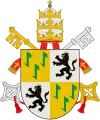 Adrian VI (Adriaan Florenszoon Boeyens (or Dedel), 1522-1523) was a commoner of Utrecht. The tinctures he used are doubtful. The arms showed quarterly, 1 and 4 three tent hooks, 2 and 4 a lion rampant. The hooks may be sable or vert, the lion may be azure or argent.[23] Adrian VI was the first pope to display his arms in the fashion which became standard, with the crossed keys in saltire passing behind the shield.[14]
Adrian VI (Adriaan Florenszoon Boeyens (or Dedel), 1522-1523) was a commoner of Utrecht. The tinctures he used are doubtful. The arms showed quarterly, 1 and 4 three tent hooks, 2 and 4 a lion rampant. The hooks may be sable or vert, the lion may be azure or argent.[23] Adrian VI was the first pope to display his arms in the fashion which became standard, with the crossed keys in saltire passing behind the shield.[14] Clement VII (1523-1534), the second of the Medici popes
Clement VII (1523-1534), the second of the Medici popes
 Julius III (1550-1555) Azure, on a bend gules fimbriated and between two olive [sometimes laurel] wreaths or, three mountains, each of as many summits, of the last.[23]
Julius III (1550-1555) Azure, on a bend gules fimbriated and between two olive [sometimes laurel] wreaths or, three mountains, each of as many summits, of the last.[23] Marcellus II (1555), Azure, on a terrace in base vert, a stag lodged argent, between six wheat-stalks [or bulrushes, in reference to Psalm 42] or.[23]
Marcellus II (1555), Azure, on a terrace in base vert, a stag lodged argent, between six wheat-stalks [or bulrushes, in reference to Psalm 42] or.[23]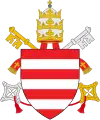

 Pius V (1566-1572)
Pius V (1566-1572)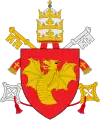 Gregory XIII (1572-1585)
Gregory XIII (1572-1585) Sixtus V (1585-1590), born Felice, son of Pier Gentile (also known as Peretto Peretti), into a poor family. He later adopted Peretti as his family name in 1551, and was known as "Cardinal Montalto". His coat of arms was D'azur au lion d'or armé et lampassé de gueules tenant un rameau d'or à la bande de gueules chargée en chef d'une étoile d'or et en pointe d'un mont à trois cimes d'argent.
Sixtus V (1585-1590), born Felice, son of Pier Gentile (also known as Peretto Peretti), into a poor family. He later adopted Peretti as his family name in 1551, and was known as "Cardinal Montalto". His coat of arms was D'azur au lion d'or armé et lampassé de gueules tenant un rameau d'or à la bande de gueules chargée en chef d'une étoile d'or et en pointe d'un mont à trois cimes d'argent.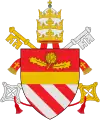 Urban VII (Giovanni Battista Castagna, pope for just thirteen days in 1590)
Urban VII (Giovanni Battista Castagna, pope for just thirteen days in 1590) Gregory XIV (Niccolò Sfondrati, 1590-1591), son of Francesco Sfondrati
Gregory XIV (Niccolò Sfondrati, 1590-1591), son of Francesco Sfondrati Innocent IX (Giovanni Antonio Facchinetti, 1591)
Innocent IX (Giovanni Antonio Facchinetti, 1591)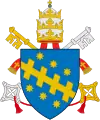 Clement VIII (Ippolito Aldobrandini, 1592-1605), used the coat of arms of the Aldobrandini family of Florence
Clement VIII (Ippolito Aldobrandini, 1592-1605), used the coat of arms of the Aldobrandini family of Florence Leo XI
Leo XI
(1605), the fourth of the Medici popes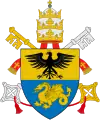 Paul V (Camillo Borghese, 1605-1621). Paul V shows the imperial eagle of the Hohenstaufen in chief, a tradition in Italian heraldry adopted by the Ghibelline faction during the War of the Guelphs and Ghibellines
Paul V (Camillo Borghese, 1605-1621). Paul V shows the imperial eagle of the Hohenstaufen in chief, a tradition in Italian heraldry adopted by the Ghibelline faction during the War of the Guelphs and Ghibellines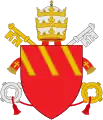 Gregory XV
Gregory XV
(1621-1623)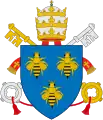 Urban VIII
Urban VIII
(1623-1644)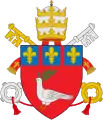
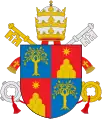 Alexander VII
Alexander VII
(1655-1667)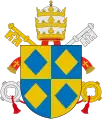 Clement IX
Clement IX
(1667-1669)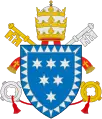 Clement X
Clement X
(1670-1676) Innocent XI
Innocent XI
(1676-1689)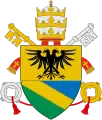 Alexander VIII (Pietro Vito Ottoboni, 1689-1691).
Alexander VIII (Pietro Vito Ottoboni, 1689-1691).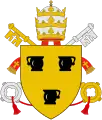 Innocent XII
Innocent XII
(1691-1700) Innocent XIII (Michelangelo Conti, 1721-1724) like Pope Innocent III (1198–1216), Pope Gregory IX (1227–1241) and Pope Alexander IV (1254–1261) was a member of the Conti di Segni, using its coat of arms, which since the 14th century had been mostly shown with the eagle crowned oriental or (also described as in chief a ducal coronet or as the crown is shown somewhat above the eagle's head)
Innocent XIII (Michelangelo Conti, 1721-1724) like Pope Innocent III (1198–1216), Pope Gregory IX (1227–1241) and Pope Alexander IV (1254–1261) was a member of the Conti di Segni, using its coat of arms, which since the 14th century had been mostly shown with the eagle crowned oriental or (also described as in chief a ducal coronet or as the crown is shown somewhat above the eagle's head) Clement XI
Clement XI
(1700-1721)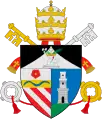 Benedict XIII
Benedict XIII
(1724-1730) Clement XII
Clement XII
(1730-1740)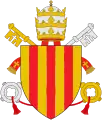 Benedict XIV
Benedict XIV
(1740-1758)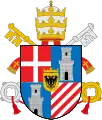 Clement XIII
Clement XIII
(1758-1769)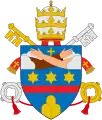 Clement XIV
Clement XIV
(1769-1774) Pius VI
Pius VI
(1775-1799)
Popes of the modern period
The last person elected as pope who was not already an ordained priest or monk was Leo X (Giovanni di Lorenzo de' Medici) in 1513. Thus, throughout the Early Modern period, the elected pope already had a coat of arms: if he did not have a family coat of arms to begin with, he would have adopted one upon being made bishop. Upon his election as pope, he would continue using his pre-existing coat of arms, in some cases with heraldic augmentations. This tradition was continued into the modern period.
| Arms | Description | Pope | Notes |
|---|---|---|---|
 | Per pale, two coats: 1. Azure, a mountain of three coupeaux in base, thereon a patriarchal cross, its arms patées or; over all the word PAX in fess fimbriated sable; 2. Per bend or and azure, on a bend argent three Moor's heads couped sable wreathed of the third; on a chief of the second three estoiles argent, 1 and 2. | Pius VII (Barnaba Niccolò Maria Luigi Chiaramonti, 1800–1823) | The first coat of arms represents the Benedictine order, the second is the Chiaramonti family coat of arms. |
 | Azure, an eagle displayed argent; also described as Azure, an eagle displayed or crowned of the same | Leo XII (Annibale della Genga, 1823–1829) | |
 | Gules, a lion rampant argent holding a castle triple-towered or. | Pius VIII (Francesco Castiglione, 1829–1830) | The attributed (traditional) arms of Celestine IV, canting arms for the name "Castiglione". |
 | Per pale two coats; 1. Azure, two doves argent drinking out of a chalice or, in chief an estoile of the second. 2. Per fess azure and argent over all on a fess gules three mullets or, in chief a hat sable. | Gregory XVI (Bartolomeo Capellari, 1831–1846) | Combines the arms of the Camaldoli order (at dexter) with those of the Capellari family (at sinister). |
 | Quarterly, 1 and 4 azure a lion rampant crowned or, its hind foot resting on a globe of the last; 2 and 3 argent two bends gules. [24] | Pius IX (Giovanni Mastai-Ferretti, 1846–1878) | The first and fourth quarters are the arms of the Mastai family, and the second and third quarters those of the Ferretti family. |
 | Azure, on a mount in base a pine tree proper; between in sinister chief a comet, or radiant star, argent, and in base two fleurs-de-lis or. Over all a fess of the third. | Leo XIII (Vincenzo Pecci, 1878–1903) | The rays of the comet are usually drawn in bend-sinister, the pine tree is usually drawn like a cypress.[24] |
 | Azure, a three tined anchor in pale above waves of the sea proper, a six pointed star or in chief, on a chief argent a lion guardant winged and with nimbus or fimbriated sable displaying an open book inscribed PAX TIBI MARCE EVANGELISTA MEUS. | Pius X (Giuseppe Sarto, 1903–1914) | Sarto was of humble origin, and he adopted a coat of arms when he became Bishop of Mantua, in 1884, consisting of the main field and charges. When he became Patriarch of Venice in 1893, he added the chief of Venice (the Lion of St. Mark), changing the field from gules (red) to argent (white) to make the heraldic point that this was the "religious emblem of St. Mark's Lion and not the insignia [of the former Republic of Venice]". When he was elected pope in 1903, heraldists expected him to again drop the chief of Venice, but Sarto did not change his coat of arms.[25] |
 | Party per bend azure and or, a church, the tower at sinister, argent, essorée gules, the tower-cross of the second, in chief or, a demi-eagle displayed issuant sable, langued gules | Benedict XV (Giacomo della Chiesa, 1914–1922) | The arms of the della Chiesa family with the imperial eagle added in chief.[26] |
 | Argent three torteaux Gules and on a chief Or an eagle displayed Sable armed Gules. | Pius XI (Achille Ratti, 1922–1939) | |
 | Azure a dove overt argent armed gules bearing an olive branch proper perched atop a trimount argent, a base wavy argent and azure soutenu by a divise vert. | Pius XII (Eugenio Pacelli, 1939–1958) |
When a bishop and cardinal Pacelli's arms depicted a dove displayed (i.e., with its wings spread) holding an olive branch in its beak, a reference to his surname, which means "peace". The dove was perched on a trimount and sitting below the arc of a rainbow, an allusion to the story of Noah. After his election to the papacy, the dove was changed to be depicted with folded wings, the rainbow was removed, and the trimount placed atop a green field above waves of water. |
 | Gules a fess argent, over all a tower between two fleurs-de-lis in chief of the same, on a chief argent a lion guardant, winged, and with nimbus or fimbriated sable displaying an open book inscribed PAX TIBI MARCE EVANGELISTA MEUS. | John XXIII (Angelo Roncalli, 1958–1963) | John XXIII used the Roncalli family's coat of arms with the addition of the chief of Venice for the Patriarch of Venice (1953), following Pius X. |
.svg.png.webp) | Gules a collee argent issuant from base beneath three fleurs-de-lis in chevron of the same. | Paul VI (Giovanni Montini, 1963–1978) | The collee, or stylized mountains or hillocks are a cant of Paul VI's family name, Montini, which means "little mountains". |
 | Azure a collee argent issuant from base beneath three mullets of five points or in chevron, points to chief, on a chief argent a lion guardant, winged, and with nimbus or fimbriated sable displaying an open book inscribed PAX TIBI MARCE EVANGELISTA MEUS. | John Paul I (Albino Luciani, 1978) | John Paul I's coat of arms was put together to reflect both of the names he chose to take. The chief containing St. Mark's lion reflects not only his own service as Patriarch of Venice (1969), but also that of John XXIII (and Pius X, who also used this chief in his own arms). Cardinal Luciani's original arms replaced the fleurs-de-lis above the collee in his immediate predecessor's arms with four-pointed stars; when Luciani was elevated to Pope they were modified to become five-pointed stars which are a heraldic symbol of Our Lady, specifically of the Assumption. |
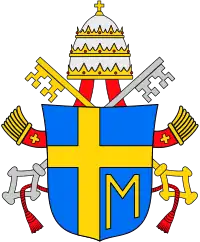 | Azure a cross or, the upright placed to dexter and the crossbar enhanced, in sinister base an M of the same. | John Paul II (Karol Wojtyła, 1978–2005) | Wojtyła adopted his coat of arms in 1958, when he was created bishop, but with the charges in black instead of gold. As this violated the heraldic "tincture's canon" (black on blue, color on color) upon Wojtyła's election as pope, Vatican heraldist Monsignor Bruno Bernard Heim suggested he replace black by gold.[27] The design shows the "Marian Cross", a cross with a capital M for Mary inscribed in one quarter, recalling "the presence of Mary beneath the cross".[28] |
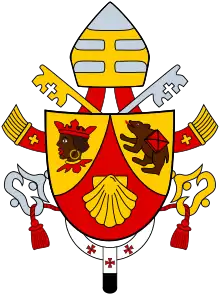 | Gules, chape ployé or, with the scallop shell or; the dexter chape with a moor's head proper, crowned and collared gules, the sinister chape a bear trippant (*passant) Proper, carrying a pack gules belted sable.' | Benedict XVI (Joseph Ratzinger, 2005–2013) | Designed by Andrea Cordero Lanza di Montezemolo in 2005. The charges, a scallop shell, Moor's head, Corbinian's bear, are taken from his previous coat of arms, used when he was Archbishop of Munich and Freising. Both the Moor's head and Corbinian's bear are charges associated with Freising in Bavaria, Germany. |
 | Azure on a sun in splendour or the IHS Christogram ensigned with a cross paty fitchy piercing the H gules all above three nails fanwise points to centre sable, and in dexter base a mullet of eight points and in sinister base a spikenard flower or.[29] | Francis (Jorge Mario Bergoglio, 2013-) | The gold star represents the Virgin Mary, the grape-like plant – the spikenard – is associated with Saint Joseph and the IHS emblem is the symbol of the Jesuits.[30][31][32] |
Related coats of arms
Notes
- Coat of Arms of His Holiness Benedict XVI Vatican. Accessed 2008-03-15.
- Christoph F. Weber, "Heraldry", in Christopher Kleinhenz, Medieval Italy (Routledge 2004 ISBN 978-0-41593930-0), vol. 1, p. 496
- "Arms of the Popes from 1144-1893" in John Woodward, A Treatise on Ecclesiastical Heraldry (London and Edinburgh 1894), pp. 158-167
- Collenberg, p. 692
- Collenberg, p. 693]
- David Brewster, The Edinburgh Encyclopædia (Routledge 1999 ISBN 978-0-41518026-9), vol. 1, p. 342
- Christine de Pizan (1364 – c. 1430), The Book of Deeds of Arms and of Chivalry (English translation: Penn State Press 1999 ISBN 9780271043050, p. 216
- Religion News Service, "Popes and conclaves: everything you need to know"
- Pastoureau 1997, pp. 283–284
- Ottfried Neubecker (1976). Heraldry: Sources, Symbols and Meaning. McGraw-Hill. ISBN 0-07-046308-5, p. 224
- John Woodward, A Treatise on Ecclesiastical Heraldry, 1894, p. 151.
- "The symbolism of the keys is brought out in an ingenious and interpretative fashion by heraldic art. One of the keys is of gold , the other of silver. The golden key, which points upwards on the dexter side, signifies the power that extends even to Heaven. The silver key, which must point up to the sinister side, symbolizes the power over all the faithful on earth. The two are often linked by a cordon Gules as a sign of the union of the two powers. The handles are turned downwards, for they are in the hand of the Pope, Christ's lieutenant on earth. The wards point upwards, for the power of binding and loosing engages Heaven itself." Bruno Bernhard Heim, Heraldry in the Catholic Church: Its Origin, Customs and Laws (Van Duren 1978 ISBN 9780391008731), p. 54)
- Claudio Ceresa, "Una sintesi di simboli ispirati alla Scrittura" on L'Osservatore Romano, 10 August 2008 Archived 18 February 2013 at Archive.today
- John Woodward, A Treatise on Ecclesiastical Heraldry, 1894, p. 153f.
- Michel Pastoureau (1997). Traité d'Héraldique (3e édition ed.). Picard. p. 49. ISBN 2-7084-0520-9.
- "Stemmi dei Sommi Pontefici dal sec. XII ad oggi" in Annuario Pontificio 1969 (Tipografia Poliglotta Vaticana, Vatican City 1969), pp. 23*-27*
- So presented at heraldique-europeenne.org and araldicavaticana.com
- John Woodward, A Treatise on Ecclesiastical Heraldry, 1894, p. 158
- John Woodward, A Treatise on Ecclesiastical Heraldry, 1894, p. 159
- John Woodward, A Treatise on Ecclesiastical Heraldry, 1894, p. 159.
- John Woodward, A Treatise on Ecclesiastical Heraldry, 1894, p. 160.
- "Heraldry" in: Philippe Levillain (ed.), Volume 2 of The Papacy: An Encyclopedia (Gaius-Proxies), Routledge, 2002, p. 693.
- John Woodward, A Treatise on Ecclesiastical Heraldry, 1894, p. 162f.
- John Woodward, A Treatise on Ecclesiastical Heraldry, 1894, p. 167
- Martin, Cardinal Jacques. Heraldry in the Vatican. Gerrards Cross: Van Duren Publishers, 1987.
- The "ghibbeline" tradition of the imperial eagle in chief here shown in the variant, "not unique in Italian heraldry", of showing only the upper half of the eagle, presumably for reasons of space, to make the eagle's feature more visible. De Chaignon la Rose (1915), pp. 1, 7.
- (Raul Pardo, 2 April 2005, Joe McMillan, 20 April 2005). Personal Flag and Arms of John Paul II (crwflags.com)
- Coat of Arms of Pope John Paul II (vatican.va). "The coat of arms for Pope John Paul II is intended to be a homage to the central mystery of Christianity, that of Redemption. It mainly represents a cross, whose form however does not correspond to any of the usual heraldry models. The reason for the unusual shift of the vertical part of the cross is striking, if one considers the second object included in the Coat of Arms: the large and majestic capital M, which recalls the presence of the Madonna under the Cross and Her exceptional participation in Redemption. The Pontiff's intense devotion to the Holy Virgin is manifested in this manner." L'Osservatore Romano, 9 November 1978.
- "Wedvick of Jarlsby - Religious/Francis, H. H. Pope 3". Archived from the original on 2013-12-06.
- "Vatican releases Pope Francis' coat of arms, motto and ring". The Telegraph. 18 March 2013. Retrieved 18 March 2013.
- "Lo Stemma di Papa Francesco". L'Osservatore Romano (Vatican website). Retrieved 18 March 2012.
- "Pope stresses simplicity, ecumenism in inaugural Mass plans". National Catholic Reporter. 18 March 2013. Retrieved 18 March 2013.
References
- Michael McCarthy, Armoria Pontificalium: A Roll of Papal Arms 1012-2006 (2007), ISBN 9780957794795.
- Donald Lindsay Galbreath, A Treatise on Ecclesiastical Heraldry. Part I. Papal Heraldry (1930), revised ed. by G. Briggs, as Papal heraldry, Heraldry Today (1972).
- P. de Chaignon la Rose, The arms of Benedict XV : an introduction to the study of papal armorials (1915), archive.org.
External links
| Wikimedia Commons has media related to Papal coats of arms. |


